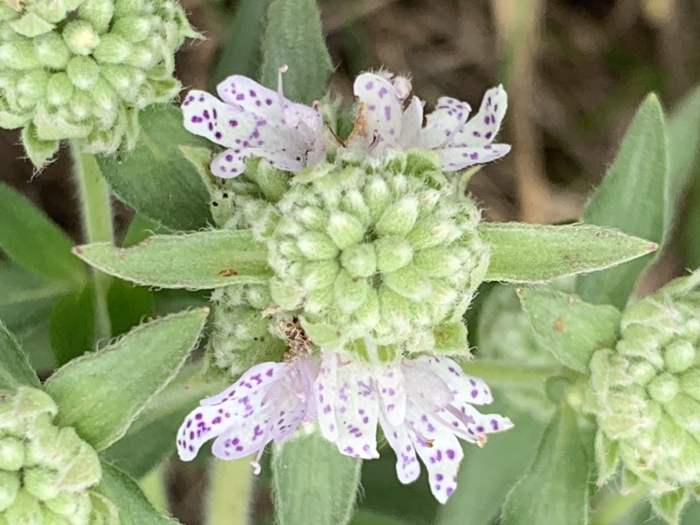Whorled Mountainmint
(Pycnanthemum verticillatum)
Whorled Mountainmint (Pycnanthemum verticillatum)
/
/

Healthy Yards
CC BY 4.0
Image By:
Healthy Yards
Recorded By:
Copyright:
CC BY 4.0
Copyright Notice:
Photo by: Healthy Yards | License Type: CC BY 4.0 | License URL: http://creativecommons.org/licenses/by/4.0/ | Rights Holder: Healthy Yards | Publisher: iNaturalist | Date Created: 2021-08-09T17:51:01Z |


















Estimated Native Range
Summary
Pycnanthemum verticillatum, commonly known as Whorled Mountainmint, is a deciduous perennial herb native to the open woodlands, grasslands, and along stream banks in the Eastern and Central United States. It typically grows to a height of 3-5 feet (0.9-1.5 meters) and a width of 1 foot (0.3 meters). The plant features a square stem and whorled leaves, which are highly aromatic when crushed. From mid to late summer, it produces dense clusters of small, tubular, two-lipped purple and white flowers that are highly attractive to pollinators.
Whorled Mountainmint is valued for its fragrant foliage and flowers, which are used in herbal teas and as a culinary herb. It is also appreciated for its ability to attract bees, butterflies, and other beneficial insects, making it a suitable choice for pollinator gardens. In cultivation, it is often used in borders, native plant gardens, and as part of naturalized areas. Whorled Mountainmint thrives in full sun to part shade and prefers medium to dry soils with good drainage. It is drought-tolerant once established and requires minimal maintenance. While generally disease-free, it can spread aggressively by rhizomes, so gardeners may need to manage its spread to prevent it from becoming invasive in a garden setting.CC BY-SA 4.0
Whorled Mountainmint is valued for its fragrant foliage and flowers, which are used in herbal teas and as a culinary herb. It is also appreciated for its ability to attract bees, butterflies, and other beneficial insects, making it a suitable choice for pollinator gardens. In cultivation, it is often used in borders, native plant gardens, and as part of naturalized areas. Whorled Mountainmint thrives in full sun to part shade and prefers medium to dry soils with good drainage. It is drought-tolerant once established and requires minimal maintenance. While generally disease-free, it can spread aggressively by rhizomes, so gardeners may need to manage its spread to prevent it from becoming invasive in a garden setting.CC BY-SA 4.0
Plant Description
- Plant Type: Herb
- Height: 3-5 feet
- Width: 0.6-1 feet
- Growth Rate: Moderate
- Flower Color: White
- Flowering Season: Summer
- Leaf Retention: Deciduous
Growth Requirements
- Sun: Full Sun, Part Shade
- Water: Low, Medium
- Drainage: Medium, Slow
Common Uses
Bank Stabilization, Bee Garden, Bird Garden, Border Plant, Butterfly Garden, Deer Resistant, Drought Tolerant, Erosion Control, Fragrant, Groundcover, Low Maintenance, Potted Plant
Natural Habitat
Native to open woodlands, grasslands, and along stream banks in the Eastern and Central United States
Other Names
Common Names: Whorled Mountain-Mint , Kranspräriemynta
Scientific Names: Pycnanthemum verticillatum , Koellia verticillata , Brachystemum verticillatum , Koellia dubia , Koellia pilosa , Pycnanthemum virginianum var. verticillatum
GBIF Accepted Name: Pycnanthemum verticillatum (Michx.) Pers.